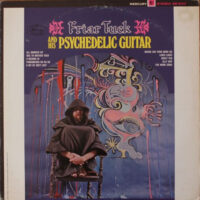
Mercury Rev’s 1992 debut album, Yerself Is Steam, was a sensation upon its release in the UK, as the music press there hyped the upstate New York group for months before it actually dropped. Americans who read said media were stoked, as well, including me and several of my Detroit-area friends. Our absurdly high expectations were exceeded. To this day, my buddies and I stan indomitably for Steam, though when music-publication chatter turns to definitive ’90s rock releases, Yerself Is Steam is largely overlooked. This makes no sense.
In the early ’90s, Mercury Rev—led by guitarists Jonathan Donahue and Grasshopper—reigned as America’s greatest rock band, the country’s grand sorcerers of whirlwind psychedelic beauty and chaos. Steam deserved its own laser-light shows and made you feel as if your blood had been replaced with rocket fuel. The first three songs on the LP—“Chasing A Bee,” “Syringe Mouth,” and “Coney Island Cyclone”—assay a rarefied strain of bubblegum-catchy freak rock that induced the sensation of being on at least three drugs you’ve never heard of. Then it gets weirder and farther out.
Even that dreaded convention of the CD era, the hidden track, pays exorbitant dividends with the decade’s ultimate waver-lighting ballad, “Car Wash Hair.” (Initially released as a single, this lovable blissout is found only on the compact disc version of Steam.) “Syringe Mouth” in particular reaches a peak of exhilarating delirium, a lysergic splurge that singed plenty of synapses in its four chaotic minutes while “Coney Island Cyclone” is the greatest song ever written about an amusement-park ride.
“Blue And Black” is an unnervingly ponderous showcase for loose-cannon singer-songwriter David Baker to flaunt his morbid croon and ponder his impending mental breakdown over a foundation of quasi-goth brooding. The group’s most prog-like moment, “Sweet Oddysee Of A Cancer Cell T’ Center Of Yer Heart” serves as a fiendish roller-coaster ride of swerving dynamics and swelling melodic grandeur that makes Porcupine-era Echo & The Bunnymen sound like flat-footed underachievers. It’s a one-off slab of monstrous brilliance in the Rev’s catalog. “Frittering” is an expansive ice floe of psychedelia that puts a seething chill on Syd Barrett-era Floyd’s epics. Speaking of epics, the ominous “Very Sleepy Rivers” meanders with an unsettling heaviness; for over 12 minutes, the band sound like they’re marching you down to your watery demise.
That Steam came out on Columbia Records (a year after its initial micro-indie release) somehow makes the whole thing even more ridiculous. Did the conglomerate’s execs get swept away by Melody Maker and NME‘s frothing praise, too? Were they looking for the next Nirvana with Mercury Rev? Did they think Suzanne Thorpe’s flute was the future of rock?
In retrospect, the early-’90s “alternative rock” frenzy probably helped Mercury Rev to sign with a major, but Columbia’s mighty marketing machine failed to move the needle for them in the US. (Grasshopper once told me that Steam has sold more than 200,000 copies worldwide over the last 31 years, most of them in Europe.) Although Mercury Rev went on to earn more commercial success with 1998’s psych-lite, Americana-leaning Deserter’s Songs, they have yet to surpass Yerself Is Steam‘s unfettered creativity. -Buckley Mayfield
Located in Seattle’s Fremont neighborhood, Jive Time is always looking to buy your unwanted records (provided they are in good condition) or offer credit for trade. We also buy record collections.













